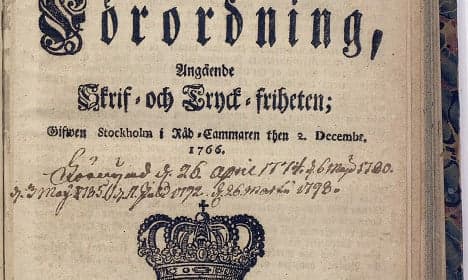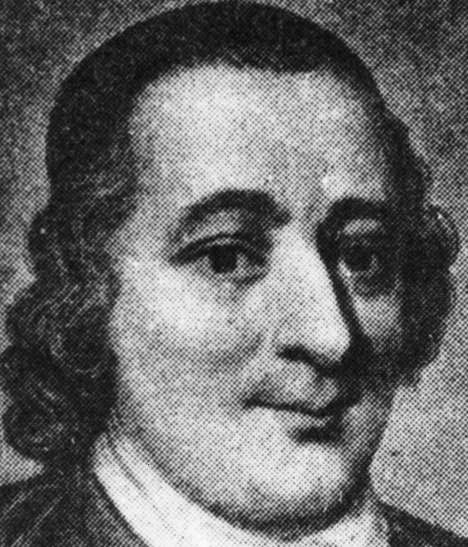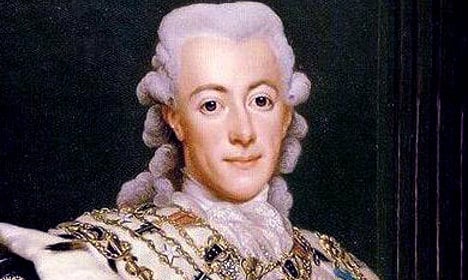Five things to know about Sweden's pioneering free press act

May 3rd is World Press Freedom Day, and Sweden's own Freedom of the Press Act is over 250 years old. Here are five things you should know about the groundbreaking document.
1. It was ahead of its time
Sweden’s Freedom of the Press Act is considered to be the oldest piece of freedom of information legislation in the world. The 1766 act came 25 years before the First Amendment of the US Bill of Rights was ratified in 1791, for example, and 200 years before the country adopted its own Freedom of Information act in 1966. It seems the Swedes have been forward-thinking for a while.
Listen. The world becomes awfully quiet without free speech. #defendingfreespeech #freespeechgreaterideas #freethespeech pic.twitter.com/0DxMfZCDb3
— Swedish MFA (@SweMFA) December 2, 2016
2. It was masterminded by a Finn
The driving force behind the act was Anders Chydenius, a liberal pastor and member of the Cap Party, one of the political forces in Sweden during the mid 1700s. He also happened to be a Finn. Finland was still part of the Kingdom of Sweden at the time, so the Finns can also celebrate their key part in the act today.

Anders Chydenius. Photo: TT
3. It gave the public power
The initial purpose of the act was to abolish political censorship of public documents and make sure everyone had the right to publish.
Just as notably though, the first version also included the rights to access publish documents, making Sweden the first country in the world to officially initiate a principle of public access to official records, and give citizens access to previously secret documents. If the openness of Swedish society can still feel a touch daunting for foreigners moving here today, imagine how revolutionary it must have felt 250 years ago!

Sweden's press couldn't exist the way it does today without the act. Photo: Margareta Gustafsson Kubista/TT
4. Its early years were tough
The act has a complicated history, not least in its early years. It was changed around 20 times between 1767 and 1844, many of which included restrictions. In 1767, with the ink barely dry on the first incarnation for example, it was made unlawful to criticize parliamentary debates. In 1790, it was made unlawful to write about the French revolution in periodicals, as King Gustav III began to feel nervy about events in France.
Gustav’s son was ultimately overthrown and in 1810 the freedoms curtailed during his father’s reign were restored. One of the biggest steps for the act came that year when the Riksdag abolished the censorship of academic and theological publications, which were exempt from the original act.
In 1812 it was expanded further to include the principles of editorial responsibility and rules for legal process.

King Gustav III. Nervy. Photo: Public domain
5. It has some exceptions
In the present day, the Freedom of Press Act is one of the four fundamental laws which govern Sweden’s constitution, and states that anyone is entitled to gain access to official documents without revealing his or her name, address or reason for the request.
It can be restricted in the case of one of seven exceptional circumstances however. Among those are the possibility to restrict the right of access if restriction is necessary for national security, central fiscal policy, preventing or prosecuting a crime, and even the preservation of animals or plant species.
Even then, it's not case closed: decisions to restrict access can still be appealed by a requester to the country’s Parliamentary Ombudsman (Justitieombudsmännen).
Propaganda and misinformation are best countered by a pluralistic flow of information #DefendingFreeSpeech #Journosafe pic.twitter.com/9EMeTXy2Es
— Swedish MFA (@SweMFA) December 1, 2016
Article first published in December 2016 and updated in May 2019
Comments
See Also
1. It was ahead of its time
Sweden’s Freedom of the Press Act is considered to be the oldest piece of freedom of information legislation in the world. The 1766 act came 25 years before the First Amendment of the US Bill of Rights was ratified in 1791, for example, and 200 years before the country adopted its own Freedom of Information act in 1966. It seems the Swedes have been forward-thinking for a while.
Listen. The world becomes awfully quiet without free speech. #defendingfreespeech #freespeechgreaterideas #freethespeech pic.twitter.com/0DxMfZCDb3
— Swedish MFA (@SweMFA) December 2, 2016
2. It was masterminded by a Finn
The driving force behind the act was Anders Chydenius, a liberal pastor and member of the Cap Party, one of the political forces in Sweden during the mid 1700s. He also happened to be a Finn. Finland was still part of the Kingdom of Sweden at the time, so the Finns can also celebrate their key part in the act today.

Anders Chydenius. Photo: TT
3. It gave the public power
The initial purpose of the act was to abolish political censorship of public documents and make sure everyone had the right to publish.
Just as notably though, the first version also included the rights to access publish documents, making Sweden the first country in the world to officially initiate a principle of public access to official records, and give citizens access to previously secret documents. If the openness of Swedish society can still feel a touch daunting for foreigners moving here today, imagine how revolutionary it must have felt 250 years ago!

Sweden's press couldn't exist the way it does today without the act. Photo: Margareta Gustafsson Kubista/TT
4. Its early years were tough
The act has a complicated history, not least in its early years. It was changed around 20 times between 1767 and 1844, many of which included restrictions. In 1767, with the ink barely dry on the first incarnation for example, it was made unlawful to criticize parliamentary debates. In 1790, it was made unlawful to write about the French revolution in periodicals, as King Gustav III began to feel nervy about events in France.
Gustav’s son was ultimately overthrown and in 1810 the freedoms curtailed during his father’s reign were restored. One of the biggest steps for the act came that year when the Riksdag abolished the censorship of academic and theological publications, which were exempt from the original act.
In 1812 it was expanded further to include the principles of editorial responsibility and rules for legal process.
King Gustav III. Nervy. Photo: Public domain
5. It has some exceptions
In the present day, the Freedom of Press Act is one of the four fundamental laws which govern Sweden’s constitution, and states that anyone is entitled to gain access to official documents without revealing his or her name, address or reason for the request.
It can be restricted in the case of one of seven exceptional circumstances however. Among those are the possibility to restrict the right of access if restriction is necessary for national security, central fiscal policy, preventing or prosecuting a crime, and even the preservation of animals or plant species.
Even then, it's not case closed: decisions to restrict access can still be appealed by a requester to the country’s Parliamentary Ombudsman (Justitieombudsmännen).
Propaganda and misinformation are best countered by a pluralistic flow of information #DefendingFreeSpeech #Journosafe pic.twitter.com/9EMeTXy2Es
— Swedish MFA (@SweMFA) December 1, 2016
Article first published in December 2016 and updated in May 2019
Join the conversation in our comments section below. Share your own views and experience and if you have a question or suggestion for our journalists then email us at [email protected].
Please keep comments civil, constructive and on topic – and make sure to read our terms of use before getting involved.
Please log in here to leave a comment.